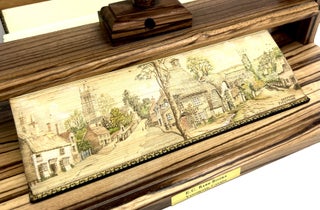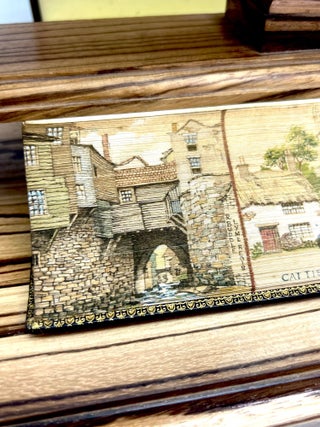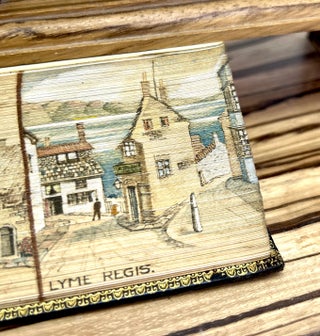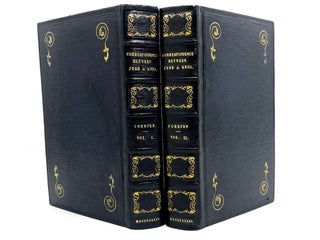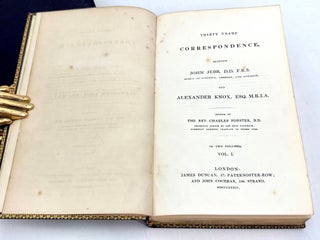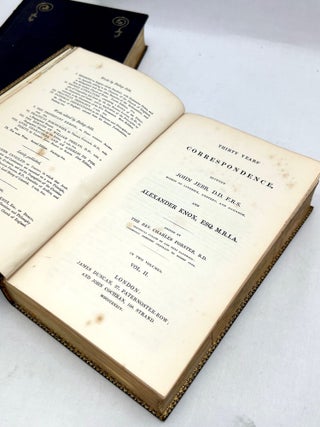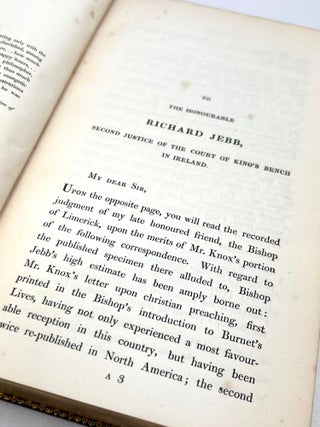THIRTY YEARS' CORRESPONDENCE BETWEEN JOHN JEBB AND ALEXANDER KNOX
London: J. Duncan and J. Cochran, 1834. Full Morocco. [FORE-EDGE PAINTING]
THIRTY YEARS' CORRESPONDENCE BETWEEN JOHN JEBB AND ALEXANDER KNOX
Edited by Charles Forster.
Published London: J. Duncan and J. Cochran, 1834.
2 Vols each with a fore-edge painting. Bound in full Maroon straight grain Morocco, bound by J. Hatchard’s and son Piccadilly. A beautiful combination of blind and gilt tooling in excellent condition.
FORE-EDGE PAINTING’S
Scenes of Dorset – Lyme Regis – Ockford - Cattistock
This incredibly detailed Fore-edge painting on Vol I is a church and street view of Okeford fitzpaine. In 1086 in the Domesday Book Okeford Fitzpaine was recorded as Adford; it had 40 households, 16 ploughlands, 21 acres (8.5 hectares) of meadow and one mill. It was in Sturminster Newton Hundred and the tenant-in-chief was Glastonbury Abbey. Since then, it has been known as "Aukford Alured" and "Ockford Phippin", the latter echoing the modern colloquial "Fippenny Ockford" and its shorthand, "Ockford".
Vol. II is even more detailed and split into 3 individual scenes.
Buddle Bridge, Lyme Regis. Believed to be the third oldest bridge in Dorset, Buddle Bridge is a delightful Grade I listed bridge hidden under the main road through Lyme Regis. Of both historical and archaeological significance, this medieval gem is best viewed looking back from Gun Cliff Walk or from the beach below at low tide. According to The Lyme Regis Society, the bridge has one arch, circa 1200-1240, which survives in a nearby cellar. The bridge, which carries Bridge Street over the river Lim, has been adapted many times although some of the original fourteenth century medieval masonry such as the four equally spaced, pointed segmental, ashlar ribs still forms part of the structure.
Cattistock Dorset. Cattistock is a village and civil parish in west Dorset, England, sited in the upper reaches of the Frome Valley, 8 miles (13 km) northwest of the county town Dorchester. The Dorset poet William Barnes called it "elbow-streeted Cattstock", a comment on the less-than-linear village street.
Lyme Regis Dorset. In Saxon times, the abbots of Sherborne Abbey had salt-boiling rights on land adjacent to the River Lym, and the abbey once owned part of the town. Lyme is mentioned in the Domesday Book of 1086. In the 13th century, it developed as one of the major British ports. A Royal Charter was granted by King Edward I in 1284 when "Regis" was added to the town's name. The charter was confirmed by Queen Elizabeth I in 1591.
John Leland visited in the 16th century and described Lyme as "a praty market town set in the rootes of a high rokky hille down to the hard shore. There cummith a shalow broke from the hilles about three miles by north, and cummith fleting on great stones through a stone bridge in the bottom."
Very Fine detailed fore-edge paintings…
Thirty Years' Correspondence between Bishop Jebb and Alexander Knox,’ edited by the Rev. C. L. Forster, Bishop Jebb's biographer. These letters show his close agreement in many points with the leaders of the Oxford movement, then beginning. In an article in the ‘Contemporary Review,’ August 1887, Professor Stokes traced the movement of thought from Wesley to Knox, from Knox to Jebb, and from Jebb to Hugh James Rose, Newman, and Pusey. The theory was impugned by Dr. Church, dean of St. Paul's, and defended by Professor Stokes in the ‘Guardian’ (7, 14, 21, and 28 Sept. 1887); but both agree that Knox anticipated much of what was afterwards insisted upon by the leaders of the revival. Keble, while admiring Knox, thought him an eclectic, looking down upon all schools with an air of superiority (Coleridge, Memoir, p. 241).
Knox contends that ‘the church of England is neither Calvinian nor Augustinian, but eminently and strictly catholic, and catholic only;’ that ‘our vitality as a church is in our identity of organisation with the church catholic;’ that the church of England is not protestant, but a reformed branch of the church catholic; that the English church is the only representative of the spirit of the Greek fathers, and that we ought to aim at union with the Greek church. He dislikes Calvinism in every form; and he argues that our justification is an imparted, not an imputed, righteousness. This last view was especially obnoxious to the evangelicals, and was opposed, among others, by G. S. Faber [q. v.] in ‘The Primitive Doctrine of Justification investigated’ (1837). Knox laments the general deadness of the services as conducted in his day; he rebels against the identification of churchmanship with toryism, and takes the primitive church in ancient times, and the seventeenth century in modern, as his models. Like Wesley, he admired mystical writers like à Kempis, De Sales, and De Renty. He had no tendency to Rome, although he was a steady advocate of catholic emancipation and a supporter of Maynooth.
He exercised a great influence through his friend Bishop Jebb. The appendix to Jebb's sermons in 1815 (not quite accurately described as the first publication that recalled men's attention to Anglo-catholic principles) was avowedly the joint production of Knox and Jebb, and it is plain that Knox was really the inspirer of the thought expounded by Jebb. Very good. Item #499
Price (USD): $2,675.00



